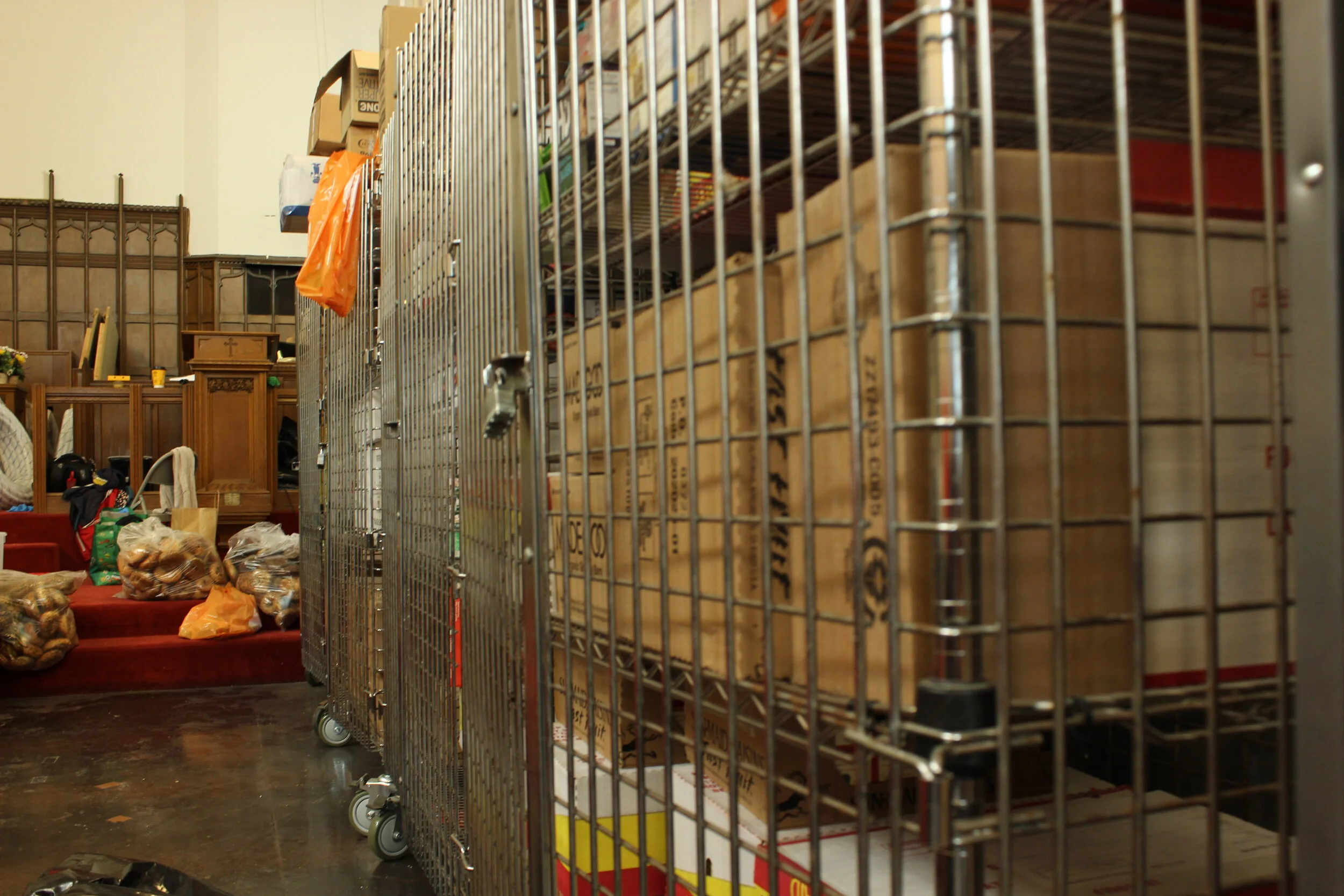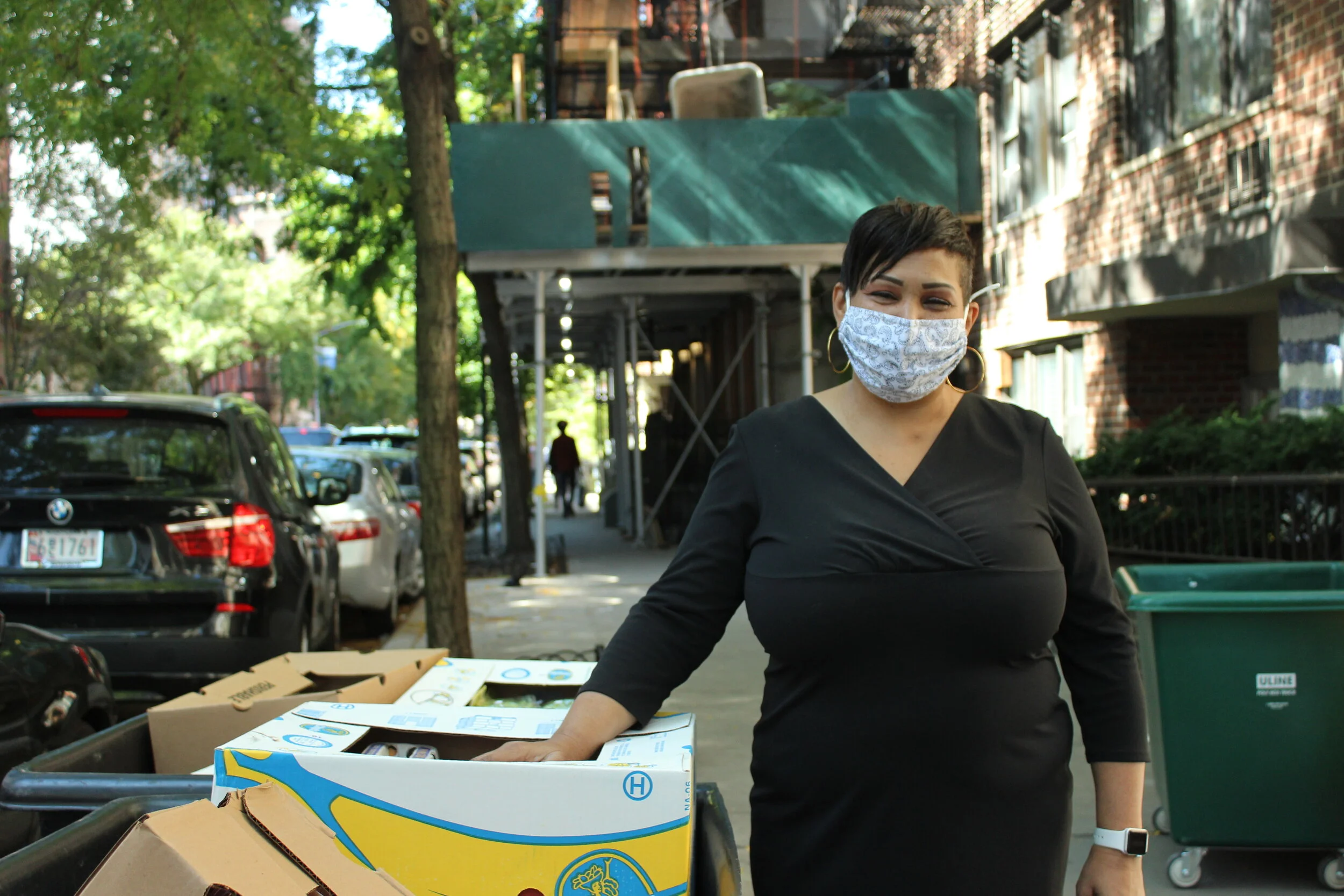
A Food Pantry That Weathered the Height of the Pandemic Is Bracing For a Second Wave
Originally published on Bedford+Bowery October 21, 2020:
A Food Pantry That Weathered the Height of the Pandemic Is Bracing For a Second Wave
On a gloomy Saturday afternoon, The Church of the Village’s sanctuary is a beehive of activity. Fifteen volunteers in masks, hairnets, and aprons unpack boxes, bag food, and move bins the size of bathtubs through the room and down the line, onto a conveyor belt to the volunteers at the entrance. It’s the last stop before the food is passed to patrons waiting patiently on the sidewalk. There’s a shelf of Gatorade, jumbo boxes of raisins, bags and bags of bagels. The food shelves stretch from the bottom of the steps by the altar, down the length of the nave, right to the door.
“Everyone leaves with a ‘shopping cart’; fresh produce, fresh fruit, real meat,” says Teresa Concepcion, executive director of Hope for our Neighbors in Need. Teresa has been involved with the food pantry and soup kitchen since 2015. Before working with the pantry, the native New Yorker served as president of the Northwest Bronx and Clergy Coalition, and worked on staff with the United Federation of Teachers. On the day we first meet, she’s in a bright orange jacket that pops against the grey of the church’s walls and sidewalk.
A mother of three, she has the energy of a parent who knows how to handle organized chaos.
And her system does look organized. But Teresa corrects me. “This isn’t what it usually looks like; this is post-pandemic,” she explains. “We made it up as we went along, but it works.”
When the COVID-19 pandemic first started back in March, the pantry and soup kitchen experienced a huge increase in numbers. “It was beyond scary,” Teresa says. “On a normal Tuesday, pre-pandemic, there would be, at the most, 350 people walking through the doors in a two-hour period. When COVID hit, we were at almost a thousand.”
Food Bank for New York City, a network of 800 food banks throughout the city, including Church of the Village, issued a report in June that detailed the rise in food insecurity city-wide when the pandemic first locked down New York. Of their network, more than half of the pantries and kitchens surveyed reported running out of food in April. 91 percent reported an increase in first-time visitors. At the height of the outbreak, 40 percent of the pantries and kitchens closed. Church of the Village kept running.
The line for the food pantry would start on Seventh Avenue, go down the block to Greenwich Avenue, back up and across 14th Street, and would end almost where it started. The lines kept getting longer and longer, as program after program shut down in the city, but HNN operated throughout the pandemic. At times, Teresa was the only person in the building, while volunteers stood outside to finish the process of handing out the food. “The numbers have gone down now,” Teresa says, “but it’s still higher than it was pre-pandemic.”
The church launched its soup kitchen and food pantry in 2003, but church members eventually tired of running it, so the job was passed on to Hope for our Neighbors in Need, and eventually, Teresa. She tells me that about 90 percent of its clientele consists of families, or elderly couples. The rest are those living on the streets or in shelters.
“If you come to our doors, it’s because you need to,” Teresa says. “So we make it as simple as possible; you come sign the book, you get the food.” No one is turned away because of zip code or faith or employment status; if you’re at the food pantry and you need the food, you’re getting the food. The soup kitchen takes place on Saturdays, when patrons can get a free meal. The food pantry, in partnership with another organization, The Red Door Place, takes place on Tuesdays, when grocery bags of produce and non-perishables are distributed.
Teresa is constantly on the phone or writing letters asking companies to sponsor the pantry; currently, Nestle is providing hot chocolate mix. “The best thing about the food we provide is that it’s food that makes them feel normal,” she says of her clientele. “It’s not from school lunch or from a government agency, it’s from Trader Joe’s, or Westside Market.”
Teresa gets stoic when she talks about the city at the beginning of the pandemic. “New York was like a movie set,” she says, “No cars. Not a person outside. It was eerie. Totally silent. I came to work and couldn’t find anywhere to eat or grab a coffee. Multiply that by someone who doesn’t have money or a home, and it’s daunting.” There were no predictors for how the pandemic was going to affect the working people of New York, but when it did so in such a catastrophic way, the pantry became a haven.
“I had a man who worked for the Hilton walk down here,” Teresa recalls. “He came down here and he almost looked shell-shocked. He said, ‘What is this?’ and I said that it was a food pantry. He said, ‘Well, what do I have to do to qualify?’ and I said, ‘Nothing, you just need to sign the book and get your food.’ He said, ‘That’s all?’ I said, ‘Yeah.’ He said, ‘Can I get it now?’ I said ‘Yeah.’ I gave him the groceries, and he was crying. He told me he just got laid off that day and he didn’t know how he was going to feed his family.”
The Church of the Village sits on a wealthy block, and the surrounding community didn’t initially welcome the crowds coming to the food pantry. At the beginning of the pandemic, Teresa recalls that “the community response was negative. They asked me what I was going to do about the lines. It wasn’t a massive amount of complaints, but it got back to my boss. My boss was very supportive of us. They said, ‘We aren’t closing, and we aren’t stopping.’”
As the pandemic upended people’s lives, the stereotype of what kind of person experiences food insecurity became obsolete. “It’s people that are newly unemployed, people with children who had to move back home,” Teresa explains. “This line is made up of seniors, because they can’t get to the stores because they need to protect themselves. We were doing food deliveries to them at the height of the pandemic. We scaled it back because that funding stream ended, so we changed it so that the seniors would wait on the corner, and a volunteer would bring it out to them. It’s been a learn-as-we-go.”
The Church of the Village is Methodist, and describes itself as “radically inclusive and anti-racist.” It is known as a historically queer space, with a historical marker for the first PFLAG meeting mounted on the church’s façade, and The Lesbian, Gay, Bisexual and Transgender Community Center right around the corner. HNN used to offer a service for LGBT+ patrons to come in and get clothing, wipes, and showers, but it had to stop when the pandemic hit. “So, we stopped the clinic and started goody bags, with all the things they’d normally get, but just outside at a table,” Teresa says.
Teresa was an inspiring figure during the difficult days. Sean, who’s worked with her for the past two and half years, credits her with his own passion to give back. “She’s one of the reasons I go the extra mile here, because she’s so devoted and compassionate, in a humanistic way.” Another volunteer, who preferred to remain anonymous, explained that she started working at the pantry and soup kitchen because of her own depression at the beginning of the pandemic, and has found community there. “Teresa is just fantastic,” she says. “Her energy is contagious, it moves people.”
Preparing for a possible second wave of the virus, Teresa is trying to stay five steps ahead by stocking up on masks, hand sanitizer, and warm clothing. “When people are out on the streets in the cold and things are shut down again, it’s going to be scary,” she says. She believes that since the pantry has already learned how to operate with fewer volunteers, they know they can do it again and spread the work throughout the building so people won’t be in contact with one another. They recently hired a grant writer to request more funding.
Teresa is eager to add more services to the program in 2021. “Make it a one- stop shopping kind of thing,” she explains, “if they need psychiatric help, if they need stuff for their kids, whatever they need, they can get it here, or get contacts for it. We’re setting the groundwork for that, but it has to be the norm.” Teresa explains that access to medical help at the beginning of the pandemic was fraught with issues that she’s trying to avoid in the future. “It was a hot mess.” Teresa says, shaking her head, “We didn’t know where to send people who had medical issues, hospitals were only taking people if it was COVID-related. I’m hoping this time around it’s better, but this time I’ve done referrals for people who might need food and clothing coming out of the hospitals. And I’m doing this to create a relationship with the hospitals, so I know who’s doing what and where so people can get the services they need.”
Throughout our interview, Teresa is pulled in a million different directions, from the check-in desk outside, to inside the sanctuary, to the downstairs kitchens. When I ask if the work ever becomes too much, if there is ever a day she wakes up and doesn’t want to do it anymore, she grins. “Not yet.”
As I leave, an elderly woman walking down the block stops and asked the volunteers in front of the church what they’re doing. When they explain the pantry service, she makes a joke about taking the food, then quickly corrects herself and says she can afford her own. As she walks away, another woman comes up to take food and make small talk with the volunteers. I wonder if in a different time, the second would have said the same thing as the first.
